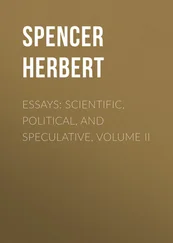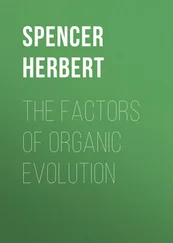Granting that the great majority of these outlying portions of nebulous matter will be drawn into the central mass long before it reaches a definite form, the presumption is that some of the very small, far-removed portions will not be so; but that before they arrive near it, the central mass will have contracted into a comparatively moderate bulk. What now will be the characters of these late-arriving portions?
In the first place, they will have either extremely eccentric orbits or non-elliptic paths. Left behind at a time when they were moving towards the centre of gravity in slightly-deflected lines, and therefore having but very small angular velocities, they will approach the central mass in greatly elongated curves; and rushing round it, will go off again into space. That is, they will behave just as we see the majority of comets do; the orbits of which are either so eccentric as to be indistinguishable from parabolas, or else are not orbits at all, but are paths which are distinctly either parabolic or hyperbolic.
In the second place, they will come from all parts of the heavens. Our supposition implies that they were left behind at a time when the nebulous mass was of irregular shape, and had not acquired a definite rotation; and as the separation of them would not be from any one surface of the nebulous mass more than another, the conclusion must be that they will come to the central body from various directions in space. This, too, is exactly what happens. Unlike planets, whose orbits approximate to one plane, comets have orbits that show no relation to one another; but cut the plane of the ecliptic at all angles, and have axes inclined to it at all angles.
In the third place, these remotest flocculi of nebulous matter will, at the outset, be deflected from their direct courses to the common centre of gravity, not all on one side, but each on such side as its form, or its original proper motion, determines. And being left behind before the rotation of the nebula is set up, they will severally retain their different individual motions. Hence, following the concentrated mass, they will eventually go round it on all sides; and as often from right to left as from left to right. Here again the inference perfectly corresponds with the facts. While all the planets go round the sun from west to east, comets as often go round the sun from east to west as from west to east. Of 262 comets recorded since 1680, 130 are direct, and 132 are retrograde. This equality is what the law of probabilities would indicate.
Then, in the fourth place, the physical constitution of comets accords with the hypothesis. [15]The ability of nebulous matter to concentrate into a concrete form, depends on its mass. To bring its ultimate atoms into that proximity requisite for chemical union—requisite, that is, for the production of denser matter—their repulsion must be overcome. The only force antagonistic to their repulsion, is their mutual gravitation. That their mutual gravitation may generate a pressure and temperature of sufficient intensity, there must be an enormous accumulation of them; and even then the approximation can slowly go on only as fast as the evolved heat escapes. But where the quantity of atoms is small, and therefore the force of mutual gravitation small, there will be nothing to coerce the atoms into union. Whence we infer that these detached fragments of nebulous matter will continue in their original state. Non-periodic comets seem to do so.
We have already seen that this view of the origin of comets harmonizes with the characters of their orbits; but the evidence hence derived is much stronger than was indicated. The great majority of cometary orbits are classed as parabolic; and it is ordinarily inferred that they are visitors from remote space, and will never return. But are they rightly classed as parabolic? Observations on a comet moving in an extremely eccentric ellipse, which are possible only when it is comparatively near perihelion, must fail to distinguish its orbit from a parabola. Evidently, then, it is not safe to class it as a parabola because of inability to detect the elements of an ellipse. But if extreme eccentricity of an orbit necessitates such inability, it seems quite possible that comets have no other orbits than elliptic ones. Though five or six are said to be hyperbolic, yet, as I learn from one who has paid special attention to comets, "no such orbit has, I believe, been computed for a well-observed comet." Hence the probability that all the orbits are ellipses is overwhelming. Ellipses and hyperbolas have countless varieties of forms, but there is only one form of parabola; or, to speak literally, all parabolas are similar, while there are infinitely numerous dissimilar ellipses and dissimilar hyperbolas. Consequently, anything coming to the Sun from a great distance must have one exact amount of proper motion to produce a parabola: all other amounts would give hyperbolas or ellipses. And if there are no hyperbolic orbits, then it is infinity to one that all the orbits are elliptical. This is just what they would be if comets had the genesis above supposed.
And now, leaving these erratic bodies, let us turn to the more familiar and important members of the Solar System. It was the remarkable harmony among their movements which first made Laplace conceive that the Sun, planets, and satellites had resulted from a common genetic process. As Sir William Herschel, by his observations on the nebulæ, was led to the conclusion that stars resulted from the aggregation of diffused matter; so Laplace, by his observations on the structure of the Solar System, was led to the conclusion that only by the rotation of aggregating matter were its peculiarities to be explained. In his Exposition du Système du Monde , he enumerates as the leading evidences:—1. The movements of the planets in the same direction and in orbits approaching to the same plane; 2. The movements of the satellites in the same direction as those of the planets; 3. The movements of rotation of these various bodies and of the sun in the same direction as the orbital motions, and mostly in planes little different; 4. The small eccentricities of the orbits of the planets and satellites, as contrasted with the great eccentricities of the cometary orbits. And the probability that these harmonious movements had a common cause, he calculates as two hundred thousand billions to one.
This immense preponderance of probability does not point to a common cause under the form ordinarily conceived—an Invisible Power working after the method of "a Great Artificer;" but to an Invisible Power working after the method of evolution. For though the supporters of the common hypothesis may argue that it was necessary for the sake of stability that the planets should go round the Sun in the same direction and nearly in one plane, they cannot thus account for the direction of the axial motions. [16]The mechanical equilibrium would not have been interfered with, had the Sun been without any rotatory movement; or had he revolved on his axis in a direction opposite to that in which the planets go round him; or in a direction at right angles to the average plane of their orbits. With equal safety the motion of the Moon round the Earth might have been the reverse of the Earth's motion round its axis; or the motions of Jupiter's satellites might similarly have been at variance with his axial motion; or those of Saturn's satellites with his. As, however, none of these alternatives have been followed, the uniformity must be considered, in this case as in all others, evidence of subordination to some general law—implies what we call natural causation, as distinguished from arbitrary arrangement.
Hence the hypothesis of evolution would be the only probable one, even in the absence of any clue to the particular mode of evolution. But when we have, propounded by a mathematician of the highest authority, a theory of this evolution based on established mechanical principles, which accounts for these various peculiarities, as well as for many minor ones, the conclusion that the Solar System was evolved becomes almost irresistible.
Читать дальше












